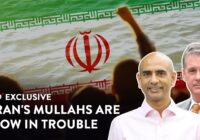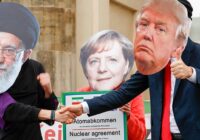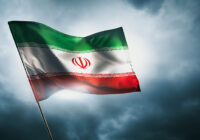Iran’s recent elections display support for the reform movement, which many believed had become obsolete.
Iran is undergoing not only an economic opening, but also a social one. After the P5+1, composed of the United Nations Security Council and Germany, signed the landmark nuclear deal with Iran last winter, countries that previously joined the US-led sanctions against the Islamic Republic are now scrambling to do business with Tehran. Iran is now a member of the international community, not of its pariah. The hardliners in the regime welcome the opening of its economy, but want to continue keeping its society closed off from Western influence.
However, recent events prove that they might be unable to do that. The momentum for the reform movement is undeniable and cannot be quashed. Despite the crushing defeat of the Green Movement in 2009 and imprisonment of its leaders, the reform movement is not dead.
Turning Point: The February Elections
The Guardian Council, a branch of government tasked with supervising elections and approving candidates, virtually barred all moderates, or those who fall in the centrist and reform camps, from running in the decisive February elections. These elections included the Majles, or Iranian parliament, and the Assembly of Experts, a council charged with overseeing the Supreme Leader and assigning his successor. The election for the latter occurs only every 8 years, and this year’s is especially significant considering the age and health of Ayatollah Ali Khamenei, the current Supreme Leader.
Of the 3,000 moderates who ran for the Majles, only 30 were approved at first. The Guardian Council was not as restrictive with the candidates for the Assembly of Experts, but still rejected 166 of the 801 reformists. One of those was the grandson of the first Supreme Leader, Hassan Khomeini. Although the Guardian Council justified his rejection by claiming he was underqualified to run, many speculate that it is because of his close ties to powerful reformists, like President Rouhani himself. After an uproar by Iranians and widespread international condemnation of the Guardian Council’s excessive restrictions on the candidates, the council reversed its initial decision and allowed more moderates to run.
In total, 55% of moderates were permitted to run for parliament, but it was still far below the 67% admitted in 2012—the first elections since the tumultuous presidential contest and subsequent 2009 Green Movement uprising against the regime. The nuclear deal was a huge boost for the reformists.
So were the 2016 election results. Despite the major restrictions, reformists came out in force and swept the vote. They captured all 30 parliamentary seats in Tehran, and dominated in every other urban district as well. In total, they won 95 of the 290 contested seats. Conservatives now occupy 92 fewer seats in the parliament after winning a record-low 103 in the February elections. The umbrella coalition for moderates and reformists (which can be loosely translated as the Pervasive Coalition of Reformists) is now virtually neck-and-neck with the less organized conservative Principilists Coalition. The runoff elections that took place on April 29 helped put even more reformists in parliament, although they were unable to clinch a majority.
The opposite sexes feel comfortable mingling in public, and women have successfully pushed the boundaries of the Islamic dress code … The youth is being increasingly exposed to the outside world through both social and traditional media, and is becoming even more critical of the government as a result.
Reformists also dominated the Assembly of Experts during the first round of elections, perhaps creating the greatest electoral upset for the conservatives. Former president and reformist-ally Akbar Hashemi Rafsanjani came in first, while the current president, Hassan Rouhani, came in third. Reformists have doubled their seats in the Assembly of Experts, from 23% in the 2006 elections to 59% in February.
Assembly members must select the next Supreme Leader should the current one pass, and even have the power to remove him, although no assembly has ever tried. Considering that Supreme Leader Khamenei is now 76 years old, and members of this reform-minded council will serve until 2024, they most likely will have to choose his successor during their tenure. If provided with this opportunity, they could elect a moderate who will be less resistant to change, and even allow an opening up of society by not blocking reform on expanding civil and human rights for the average Iranian.
Evolution of the Reform Movement
Many Iranians are doubtful that the country will undergo any significant change regardless of the election result. The Supreme Leader still makes the final decision and holds most power in the republic. Any efforts for reform are futile as long as the Supreme Leader is unwilling to accept them. Skeptics will point to the last period when reformist Mohammad Khatami served as president to emphasize how ineffectual attempts to instill reform has been in the past.
Khatami’s election as president in 1997 opened the doors for the development of civil society. People were inspired by his calls for democratic freedom and felt the opportunity to be more outspoken against the government. Non-profit organizations flourished under the new administration that allowed and, more importantly, encouraged their conception.
Khatami eased restrictions on the media, which created a space for criticism of the Islamic Republic and exposure to viewpoints other than the heavily-censored government news channels. However, in 1999, fearing the impact that Khatami’s liberalization was having on society, the Special Court for Clerics ordered the closure of the major left-wing newspaper, Salam, that had helped give rise to Khatami during the presidential elections.
The court’s decision, acting under the direct jurisdiction of the Supreme Leader and accountable only to him, sparked mass student protests in Tehran. Khamenei ordered a brutal crackdown on the protests, which led to multiple deaths and hundreds of arrests. Instead of condemning the attacks, Khatami sided with the Supreme Leader by calling for an end to the protests. The 18th of Tir Crisis, as it became known, serves as a reminder to many of the government’s intolerance toward reform, even if it is implemented by an elected president. It also instilled distrust toward reformist political leaders who seem more beholden to the Supreme Leader and preserving the Islamic Republic instead of reforming it.
Khatami’s decision to side with the Supreme Leader was a strategic one. Khatami strongly believed that the only hope for liberalizing Iran and reconciling democracy with Islam was to operate within the political system instead of against it. Although it was relatively unknown at the time, the Islamic Revolutionary Guardian Corps (IRGC)—an armed wing of government that acts on the behest of the Supreme Leader—threatened to overthrow Khatami if he sided with the protesters—his supporters. Khatami could only make substantial reform if he remained as the president instead of an outlaw, and made what was arguably the best decision he could have for the long-term success of reform.
Although many of his reforms in his 8-year tenure as president were reversed by his successor, Mahmoud Ahmadinejad, the seeds of reform had been sowed to allow for organic societal change. Many of the hundreds of social organizations created under Khatami’s presidency continue to exist today, and work tirelessly to expand civil rights inside the Islamic Republic. After Khatami, and especially under Rouhani, the lines between the public and private spheres have become blurred. After taking on the reins as president, Rouhani announced that he would divest in the “morality police” which meant less enforcement of laws like the strict Islamic dress code and mingling with someone who non-mahram, or single and of the opposite sex.
The opposite sexes feel comfortable mingling in public, and women have successfully pushed the boundaries of the Islamic dress code by adorning tight manteaus, or the mandated coat, and slipping their hijab further back, revealing most of their hair. The youth is being increasingly exposed to the outside world through both social and traditional media, and is becoming even more critical of the government as a result. This manifested in the 2009 Green Movement, when thousands poured into the streets to protest the reelection of Mahmoud Ahmadinejad in what was believed to be a fraudulent victory over the reformist candidate Mir Hossein Mousavi.
This reform movement took a blow in 2009. The crackdown saw dozens killed and disappeared, hundreds arrested, many of whom continue to be held indefinitely in the notorious Evin Prison. Authorities placed the de-facto leaders of the Green Movement, Mousavi and the other reformist presidential candidate Mehdi Karroubi under house arrest, where they continue to be held. Social media was severely restricted after that, with even the most advanced VPNs being unable to penetrate the government’s firewalls. While this may have stalled the movement’s ability to organize effectively, it could not disable the belief in the need for reform.
The hardliners understand that they must tread carefully now while operating under the auspice of the nuclear deal, and must find a balance between continuing to suppress society to avoid a seizure of government by the reformists and appeasing the international community.
If anything, the crackdown affirmed the necessity for reform and an opening of Iran. In 2013, Rouhani was elected president by running on a platform of working with the West and opening Iran’s economy. He was pitted against current mayor of Tehran, the hardliner Mohammad Bagher Ghalibaf, who has held various positions throughout the Iranian security apparatus that includes the IRGC, the very organization that threatened to overthrow Khatami. The government, understanding that it could not risk another outbreak of an uprising like the Green Movement, chose not to intervene in the election of another reformist president. They are now facing the consequences.
Opening Up
Understanding that it would be difficult to force change inside the government, Rouhani has instead sought to advance liberalizing Iran by opening up its economy. Khatami adopted a dualistic approach as president: On the one hand, he pursued a form of “economic diplomacy” through free market reforms to encourage greater foreign investments and, on the other, he relaxed restrictions on the press, media and civil liberties.
The moment that the hardline establishment felt like it was losing control over society under the Khatami presidency, they reversed his reforms and threatened to overthrow him. Now there is a media ban on Khatami that prohibits journalists from quoting his statements or publishing images of him, although activists have taken to social media to defy it.
Rouhani, however, has free rein and must not lose it. His strategy to focus on economic reform will simultaneously, albeit slowly, open up Iranian society. The nuclear deal embodies the strength of this this strategy over Khatami’s initial implementations of change. As a newly-integrated member of the international community, Iran is now expected to adhere to international law and norms adopted by a global conglomerate like the United Nations (UN). It can no longer be “rogue,” like North Korea, without facing severe consequences.
Iran, more than any other country, understands the implications of being ostracized: crippling economic sanctions, exclusion from regional talks that will decide on issues critical for the Islamic Republic and a growing diaspora that has created a “brain-drain” of its most well-educated citizens. Iran cannot afford to crawl back to pre-nuclear deal conditions.
By opening up Iran’s economy to the world through the nuclear deal, Rouhani has opened the doors for political liberalization through organic societal change instead of institutionalizing it. Corporations and businesses alike are enthusiastic about conducting business with Iran, and the steady flow of commerce will undoubtedly expose Iranians to other cultures and lifestyles. While many in the hardline establishment may condemn this impeding “westoxification”—a popular term coined by Iranian writer Jalal Al-e-Ahmad—of society, it is the price they will have to pay for the economic growth.
Reformists like Khatami will argue that liberalization of Iran can be compatible with the principles of the Islamic Republic. The reform movement is predicated on this compatibility between Islam and democracy, and the years ahead will test how Tehran handles the opening of its society to the outside, liberal world.
The recent elections show how these changes are starting to make an impact. There were no additional restrictions on the internet and mobile communications during the recent election cycle, and even the initial decision by the Guardian Council to severely limit the candidates was reversed. Rouhani understood that the nuclear deal would not only mean the lifting of sanctions, but also its inclusion into the international community. While the actions of Tehran may have always been heavily monitored and scrutinized by the rest of the world, now it is susceptible to repercussions if those actions are deemed as violations of international law and global norms.
The hardliners understand that they must tread carefully now while operating under the auspice of the nuclear deal, and must find a balance between continuing to suppress society to avoid a seizure of government by the reformists and appeasing the international community. Stepping back and allowing the elections to take place without heavy intervention that allowed the reformists to rise is one example of that balancing act.
The reform movement has made a comeback. Reformists now hold a significant presence in the most powerful branches of government and will be trying to win over their conservative counterparts to continue the momentum of the nuclear deal and continue to expand Iran’s economy in hopes of opening up its society. If Rouhani could gain the support of the hardline majority parliament before the recent elections, a more evenly-split one will undoubtedly help Rouhani accomplish even more.
As an increasing amount of Iranians begin demanding change in civil, human and political rights, it will be difficult for the hardline establishment to continue to suppress the inevitable liberalization of the country. The nuclear deal has awarded Iranians with the opportunity to more freely do business, exchange ideas and even values with people around the world. The reform movement is far from being dead—it is thriving.
The years ahead will provide another opportunity for leaders to convince the Iranian public to subscribe to their strategy of navigating the political system from within instead of against it. This year’s elections serve as a testament that an increasing number of people believe in this path to reform. Next year’s presidential election will demonstrate whether the hardline establishment will continue to let it happen and face the consequences either way.
The views expressed in this article are the author’s own and do not necessarily reflect Fair Observer’s editorial policy.
Photo Credit: Mohammadali F. / Flickr
 We bring you perspectives from around the world. Help us to inform and educate. Your donation is tax-deductible. Join over 400 people to become a donor or you could choose to be a sponsor.
We bring you perspectives from around the world. Help us to inform and educate. Your donation is tax-deductible. Join over 400 people to become a donor or you could choose to be a sponsor.
Support Fair Observer
We rely on your support for our independence, diversity and quality.
For more than 10 years, Fair Observer has been free, fair and independent. No billionaire owns us, no advertisers control us. We are a reader-supported nonprofit. Unlike many other publications, we keep our content free for readers regardless of where they live or whether they can afford to pay. We have no paywalls and no ads.
In the post-truth era of fake news, echo chambers and filter bubbles, we publish a plurality of perspectives from around the world. Anyone can publish with us, but everyone goes through a rigorous editorial process. So, you get fact-checked, well-reasoned content instead of noise.
We publish 2,500+ voices from 90+ countries. We also conduct education and training programs
on subjects ranging from digital media and journalism to writing and critical thinking. This
doesn’t come cheap. Servers, editors, trainers and web developers cost
money.
Please consider supporting us on a regular basis as a recurring donor or a
sustaining member.
Will you support FO’s journalism?
We rely on your support for our independence, diversity and quality.






